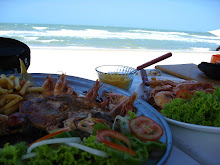Despite the nationwide, planned strike in Greece, many of the government ran sites in Crete were up and running -- including the ancient Minoan palace, Knossos, our main destination that day. We drove about 1.5 hours to the capital of Crete, Iraklio (also spelled: Heraklion), a sprawling metropolis and the largest city on Crete (and the fifth largest city in Greece) -- we were going to venture back to Iraklio later in the day, but had to drive through Iraklio to reach Knossos. The ruins of Knossos, surrounded by green hills and dusty roads, was uncovered in 1900 by British archaeologist, Sir Arthur Evans. According to our tour guide, the excavators were stunned by what they found -- a sophisticated civilization from four thousand years ago that had running water (that they brought in from a mountain, miles away, through a complex piping system), flushing toilets, beautiful frescoes, and such. Unlike the other archaeological sites / palace ruins around Crete, Knossos was "reconstructed" in part to give visitors an idea of what the palace would have looked like when ruled by the Minoans. The day we visited, the weather was brilliant... literally. Not a cloud in the sky, the sun was beaming down on Knossos. And it was quite warm. I loved exploring Knossos and learning about the myths that interweave with the actual "history" of Knossos ... as the legend goes, King Minos hid the mythological beast, the Minotaur, down underneath Knossos in the Labyrinth. Although it is unlikely that a Minotaur was actual hidden in a Labyrinth, our tour guide explained to us that some believe that the word "labyrinth" comes from the Minoans -- one of the symbols of the Minoans was the double axe. The word for the double axe was "labrys"... leading to the word, labyrinth... This was just one of many fun facts that we learned as part of our tour! (On a sidenote, if you do visit Knossos, you can find a tour guide once you enter the palace area. There is a booth where you can hire a guide -- either as part of a small group or for a higher fee, for a one-on-one tour ... often, the tour guides will approach you before you even get to the booth.)
After we visited Knossos, we were starving and drove into Iraklio for a later lunch. We had a few spots in mind, some that overlooked the water... but after 45 minutes of navigating through the very narrow streets of downtown Iraklio and attempting to find parking, we decided to forego lunch and just go to the Archaeological Museum. On our walk to the Archaeological Museum, we came across a hot dog/sandwich food stop... we were going to just purchase a water or two, but well, could not resist getting something to eat. So we shared the "double hot dog" and also had the good fortune to meet some very nice locals, who we chatted with a bit to find out more about the layout of the city and the culture of the city. Again, we were struck by the generosity and friendliness of the Greeks. And we were very happy with our tasty grilled hot dog...(Oh and we did make it to the Archaeological Museum...covered in sweat...the original Arch Museum was undergoing renovations, so all the "highlights" of the Arch Museum had been moved to a rather small one story rectangular building. They sure jammed quite a few artifacts into this small room. It is wonderful to see after visiting Knossos, because many of the items at the Museum are from Knossos, and include several beautiful frescoes. But I don't necessarily think this Museum is worth a side visit to Iraklio unless you are already there.)








No comments:
Post a Comment